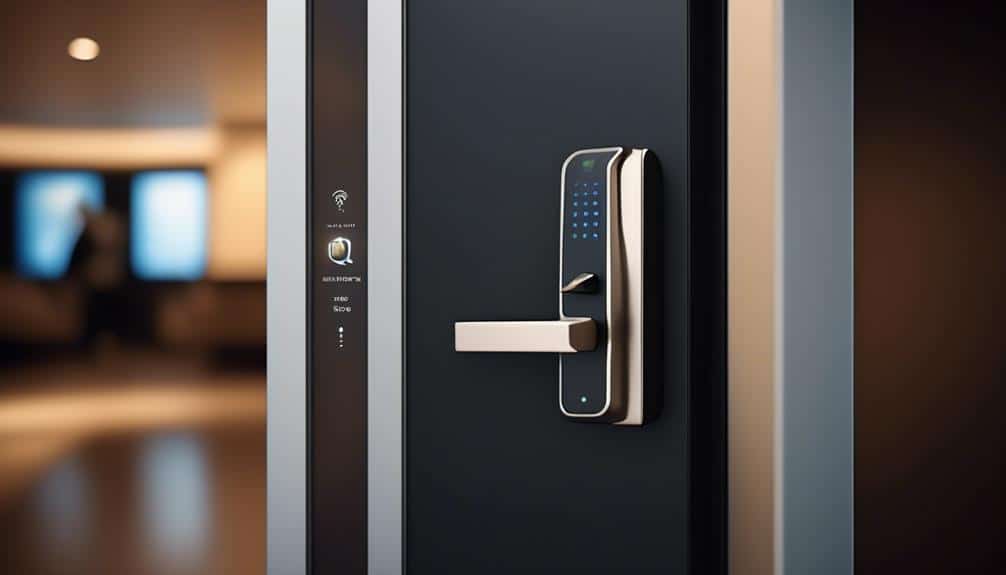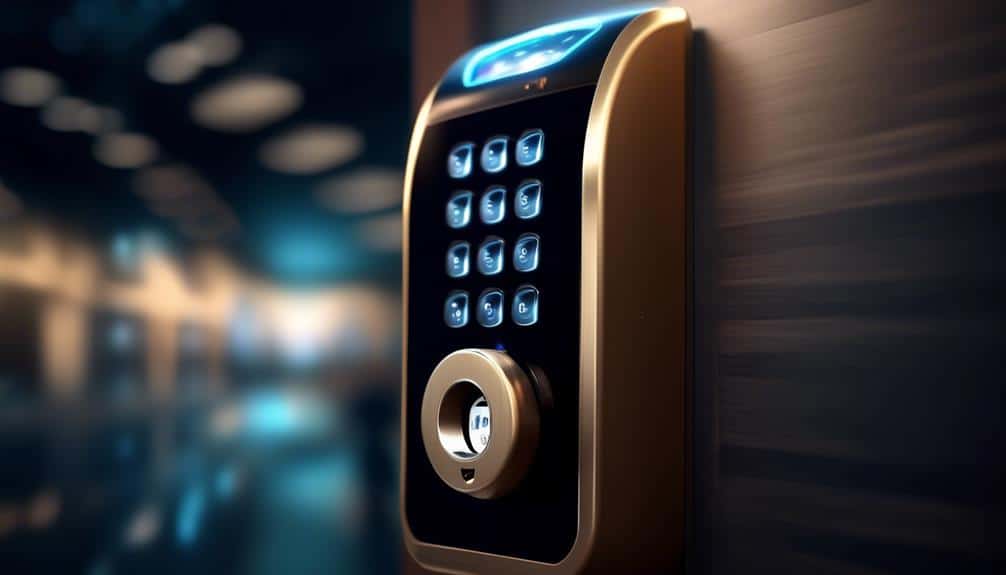Imagine a world where your security is as impenetrable as a fortress, where only those with the proper credentials can gain access.
In this ever-evolving digital age, electronic access control locks have emerged as the guardians of our most valuable assets. From biometric locks that rely on fingerprints or retinal scans to keyless entry systems that eliminate the need for traditional keys, there are a multitude of options available to ensure maximum security.
But which locks reign supreme?
Join us as we explore the top electronic access control locks that will leave you hanging on the edge of your seat, eager to discover the ultimate solution for your security needs.
Biometric Locks

Biometric locks offer a highly secure and convenient electronic access control solution by using unique physiological characteristics for identification. These locks provide several benefits over traditional key or card-based systems.
Firstly, biometric locks offer a higher level of security since they rely on individual characteristics such as fingerprints, iris patterns, or facial recognition, which are extremely difficult to replicate or forge. This eliminates the risk of unauthorized access due to stolen or misplaced keys or cards.
Additionally, biometric locks provide a more convenient solution as users no longer need to carry or remember keys or access cards. With a simple scan or touch, authorized individuals can gain access to secure areas.
When choosing the right biometric lock for your needs, it's important to consider several factors.
Firstly, consider the level of security required for your application. Some biometric locks offer multiple layers of authentication, such as combining fingerprint and iris recognition, for added security.
Secondly, consider the ease of use and compatibility with existing systems. Look for locks that have user-friendly interfaces and can integrate seamlessly with your current access control infrastructure.
Finally, consider the scalability of the system. If you have plans to expand or upgrade your security system in the future, choose a biometric lock that can accommodate these changes.
Keyless Entry Systems

Keyless entry systems offer a secure and convenient way to access controlled areas without the need for traditional keys or access cards. With advancements in wireless technology, keyless entry systems have become even more efficient and reliable.
Here are some key features and advancements in keyless entry systems:
- Wireless technology for keyless entry systems:
- Bluetooth: Keyless entry systems can now be connected to smartphones via Bluetooth, allowing for seamless access control.
- Wi-Fi: Some keyless entry systems utilize Wi-Fi to enable remote access and control, providing flexibility and convenience.
- Advancements in encryption algorithms for keyless entry systems:
- AES-256 encryption: The use of Advanced Encryption Standard (AES) with a 256-bit key ensures a high level of security, making it extremely difficult for unauthorized individuals to gain access.
- Two-factor authentication: Keyless entry systems now incorporate two-factor authentication, combining something the user knows (such as a PIN) with something the user possesses (such as a smartphone), further enhancing security.
These advancements in wireless technology and encryption algorithms have significantly improved the security and functionality of keyless entry systems. With their ease of use and robust security features, keyless entry systems are becoming increasingly popular in various industries, including commercial buildings, residential complexes, and government facilities.
Proximity Card Locks

Proximity card locks are widely used in access control systems for their reliable and efficient operation. These locks utilize RFID (Radio Frequency Identification) technology to grant or deny access to authorized individuals.
The proximity card, typically a small plastic card or key fob, contains an embedded RFID chip that communicates with the lock when brought into proximity. This enables quick and convenient access without the need for physical keys or PIN codes.
One of the key advantages of proximity card locks is their compatibility with access control management systems. These systems allow administrators to easily manage and monitor access permissions for different individuals or groups. Access control management software enables the creation and modification of access rules, granting or revoking access privileges in real-time. This provides a high level of flexibility and control over who's access to specific areas or resources within a facility.
Furthermore, proximity card locks offer enhanced security features. The use of encrypted RFID technology ensures that the communication between the card and the lock is secure and can't be easily compromised. Additionally, the cards can be easily deactivated and reprogrammed if lost or stolen, preventing unauthorized access.
Smart Locks

Smart locks have revolutionized the way we secure and access our homes and businesses. With their advanced features and capabilities, smart locks offer enhanced convenience and security compared to traditional locks.
Here are some key aspects of smart locks:
- Wireless connectivity options:
- Smart locks can connect to Wi-Fi networks, allowing remote access and control via smartphone applications.
- Some smart locks utilize Bluetooth technology, enabling easy unlocking when the user is in close proximity.
- Integration with home automation systems:
- Smart locks can be integrated with home automation systems, such as Amazon Alexa or Google Assistant, for seamless control using voice commands.
- They can also integrate with other smart devices, such as security cameras or doorbell cameras, to create a comprehensive home security ecosystem.
Multi-Factor Authentication Systems

Multi-factor authentication systems enhance security by requiring multiple forms of identification before granting access. These systems provide an additional layer of protection against unauthorized access, making them crucial for maximum security.
Two factor authentication methods are commonly used in multi-factor authentication systems. One popular method is the combination of a password and a one-time password (OTP) sent to a user's mobile device. This ensures that even if a password is compromised, an attacker would still need access to the user's mobile device to gain entry.
To further secure passwords, password encryption techniques are employed. This involves transforming a password into an unreadable format using encryption algorithms. Encryption helps prevent unauthorized individuals from gaining access to sensitive information, as even if the encrypted password is obtained, it can't be easily deciphered without the encryption key.
Additionally, encryption techniques such as hashing can be used to further protect passwords by converting them into a fixed-length string of characters. This makes it extremely difficult for hackers to reverse-engineer the original password.
Frequently Asked Questions
Can Electronic Access Control Locks Be Easily Hacked or Bypassed?
When evaluating the vulnerability of electronic access control locks to hacking or bypassing, we must analyze the effectiveness of current security measures. It's important to determine if these locks can be easily hacked or bypassed.
Our team has conducted extensive research on this matter and found that while some electronic access control locks may have vulnerabilities, the top models on the market have implemented robust security measures to prevent hacking or bypassing.
Are Electronic Access Control Locks Compatible With Existing Security Systems?
Yes, electronic access control locks are compatible with existing security systems.
Integrating electronic access control locks into an existing security system offers numerous benefits. It allows for centralized control and monitoring, providing a higher level of security.
Additionally, electronic access control locks can be easily programmed to restrict access to specific areas or individuals, enhancing overall security measures.
The seamless integration of electronic access control locks with existing security systems ensures maximum protection and peace of mind.
What Happens if There Is a Power Outage? Will the Lock Still Function?
During a power outage, the functionality of electronic access control locks can be affected.
To ensure continuous operation, it's important to have backup power sources, such as battery backups or generators, in place.
These measures help mitigate the impact of power outages and ensure that the locks remain operational.
Can Electronic Access Control Locks Be Remotely Controlled or Monitored?
Yes, electronic access control locks can be remotely controlled and monitored. This feature allows for convenient management of access permissions and real-time monitoring of the lock's status.
However, it's important to consider the security risks associated with remote control capabilities. Unauthorized access or hacking attempts could compromise the security of the lock system.
Therefore, it's crucial to implement robust security measures, such as encryption protocols and strong authentication methods, to mitigate these risks.
What Happens if I Lose My Access Card or Forget My PIN Code? Can I Still Gain Entry?
If you happen to lose your access card or forget your pin code, don't panic! There are alternative methods available to gain entry.
Depending on the system, you may be able to use a backup access card or a secondary pin code.
If all else fails, contact the system administrator or security personnel for assistance. They'll guide you through the necessary steps to regain access and ensure the security of the premises.

